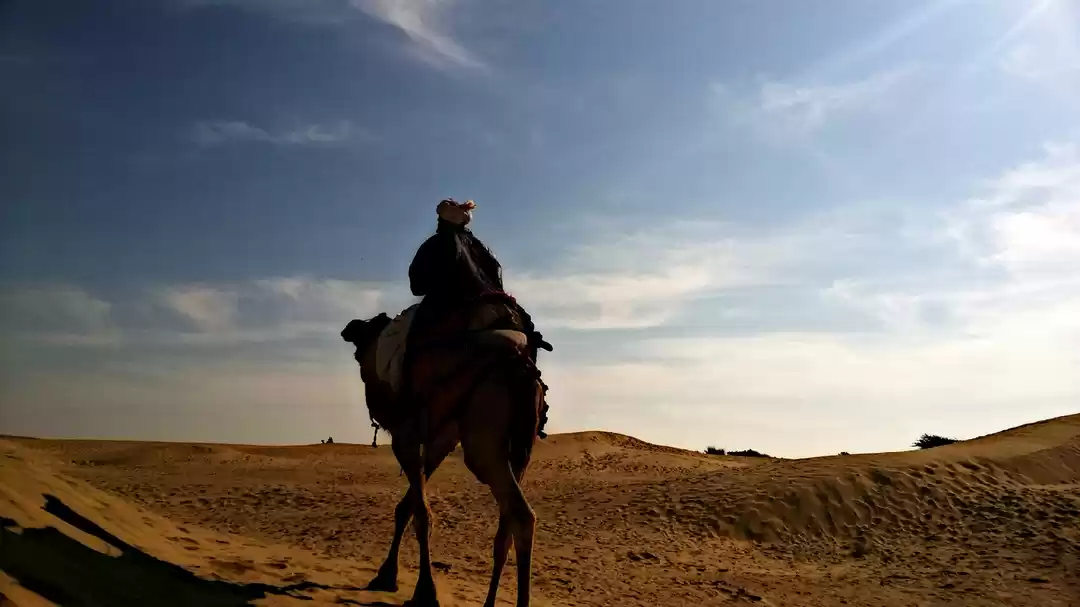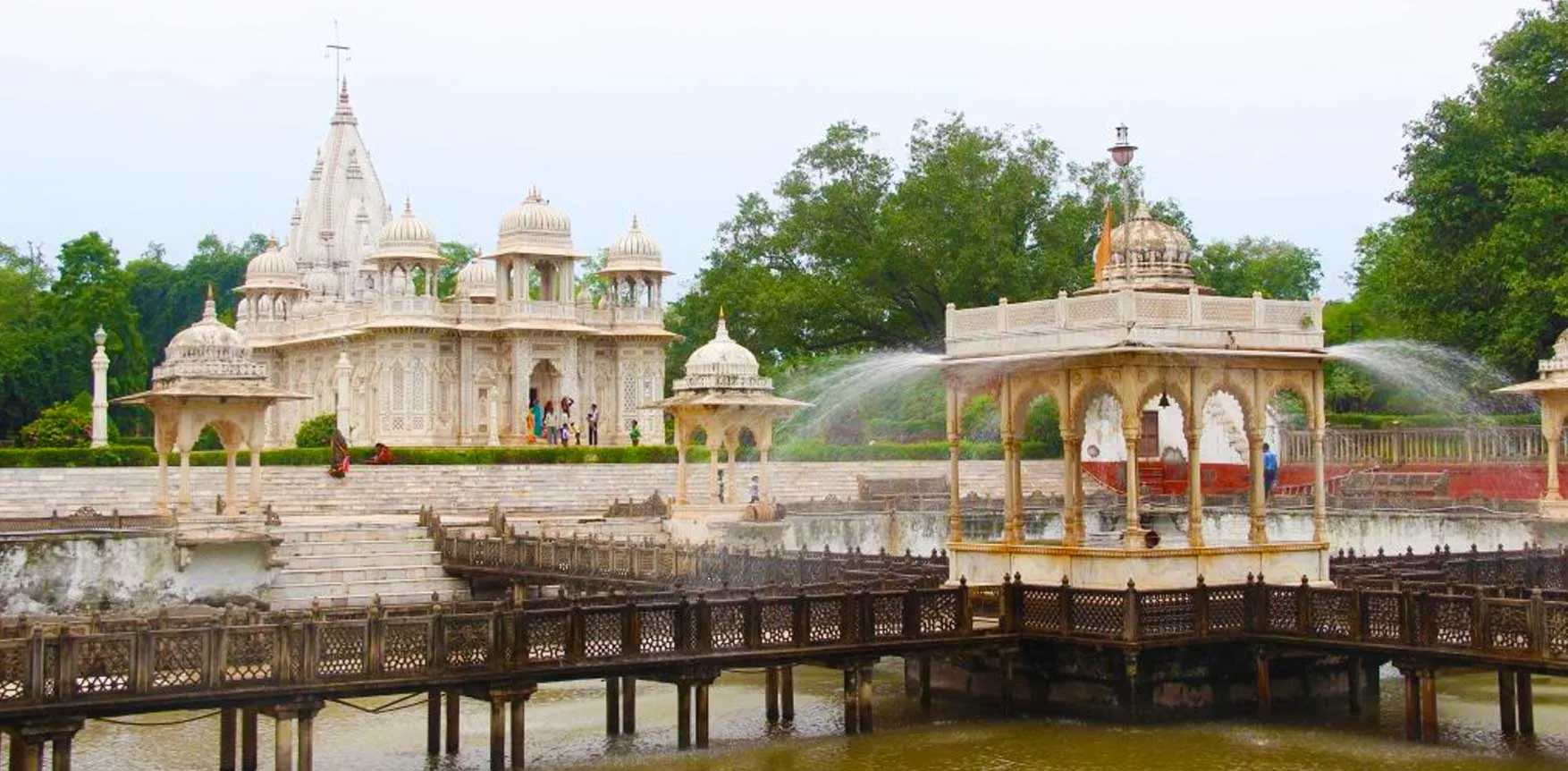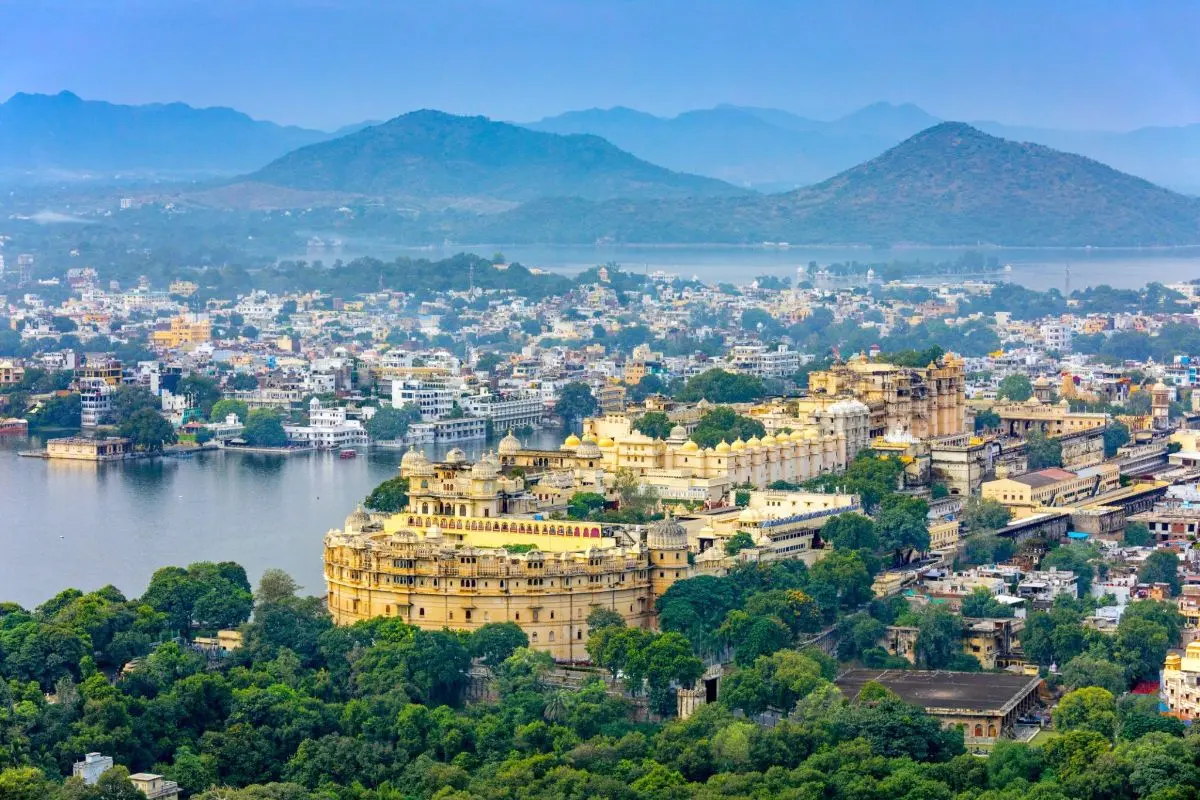Udaipur, often referred to as the “Kashmir of Rajasthan,” is a city that embodies the essence of scenic beauty and cultural richness. Nestled in the southern part of Rajasthan, Udaipur is renowned for its intricate palaces, serene lakes, and lush gardens, making it a picturesque and tranquil destination. The city’s majestic architecture, exemplified by landmarks such as the City Palace and Lake Palace, stands in harmony with the natural beauty of Lake Pichola and Fateh Sagar Lake. Udaipur’s blend of historic grandeur and natural splendor offers a unique and captivating experience, reminiscent of the idyllic landscapes of Kashmir, earning it this distinguished nickname.
The Lake Palace
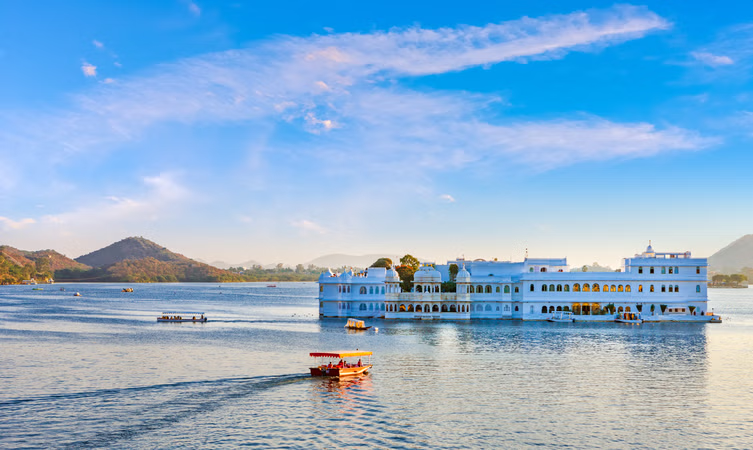
The Lake Palace, also known as Jag Niwas, is an exquisite architectural marvel situated on the serene waters of Lake Pichola in Udaipur. Built in the 18th century by Maharana Jagat Singh II, this stunning white marble palace appears to float gracefully on the lake, creating a mesmerizing and ethereal sight. Once the summer retreat of the royal dynasty of Mewar, the palace is now a luxury hotel, offering a blend of regal charm and modern amenities. Its intricate design, featuring ornate carvings, decorative arches, and lush courtyards, reflects the opulence and grandeur of Rajasthan’s royal heritage. The Lake Palace stands as a symbol of Udaipur’s romantic allure, attracting visitors from around the world who seek to experience its timeless beauty and tranquility.
Fateh Sagar Lake
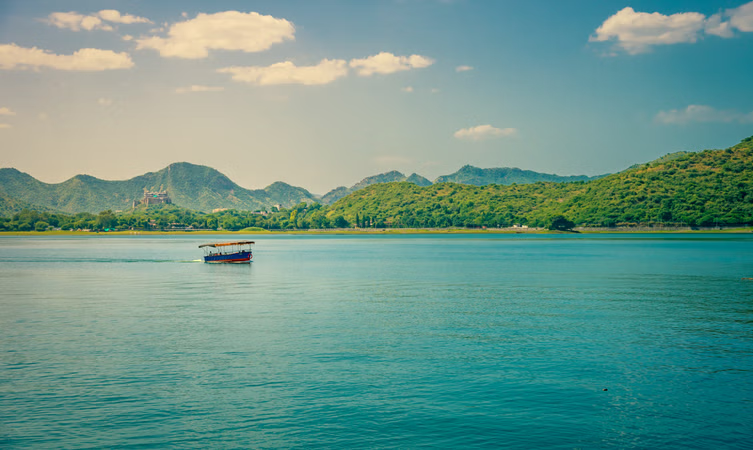
Fateh Sagar Lake, located in the heart of Udaipur, is a pristine artificial lake that embodies the city’s enchanting beauty and serene ambiance. Constructed in the late 17th century by Maharana Fateh Singh, after whom it is named, the lake is surrounded by the majestic Aravalli Hills and offers a tranquil escape from the bustling city life. Fateh Sagar Lake comprises three small islands, the largest of which houses Nehru Park, a popular recreational spot featuring a boat-shaped restaurant and a zoo. The lake’s calm waters, coupled with the picturesque views of lush greenery and rolling hills, make it a favored destination for boating, picnicking, and leisurely strolls along its scenic promenade. Fateh Sagar Lake is a testament to Udaipur’s reputation as the “City of Lakes,” showcasing the harmonious blend of natural beauty and royal legacy.
City Palace
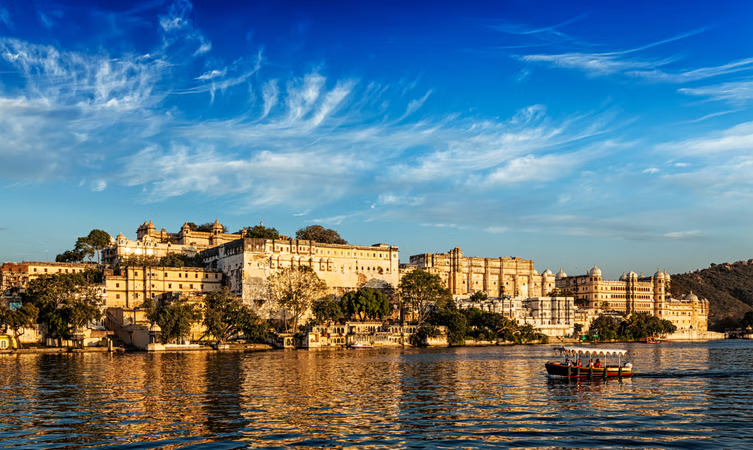
The City Palace of Udaipur, perched majestically on the eastern banks of Lake Pichola, is an epitome of grandeur and architectural brilliance. Constructed over nearly 400 years by successive rulers of the Mewar dynasty, this sprawling palace complex is a splendid fusion of Rajasthani and Mughal architectural styles. The City Palace is a labyrinth of royal courtyards, intricately decorated halls, terraces, pavilions, and hanging gardens, offering breathtaking views of the lake and the city below. Notable attractions within the palace include the Peacock Courtyard, the Mirror Palace, and the intricate marble and granite work of the Jagdish Temple. Today, the City Palace stands as a testament to the opulence and artistic heritage of Udaipur, drawing visitors with its rich history, stunning architecture, and panoramic vistas.
Lake Pichola

Lake Pichola, one of the most beautiful and picturesque lakes in Udaipur, Rajasthan, is an artificial freshwater lake created in the 14th century by a Banjara tribesman to meet the water needs of the city. Surrounded by grand palaces, historic temples, and charming havelis, the lake is synonymous with Udaipur’s regal charm and romantic ambiance. The Lake Palace, an iconic structure, appears to float effortlessly on its waters, while the Jag Mandir Island offers a serene retreat with its lush gardens and marble edifices. Boating on Lake Pichola is a popular activity, providing stunning views of the City Palace, the old city, and the distant Aravalli Hills. At sunset, the lake’s waters reflect the golden hues of the sky, creating a mesmerizing and tranquil scene that captures the essence of Udaipur’s timeless beauty.
Vintage Car Museum
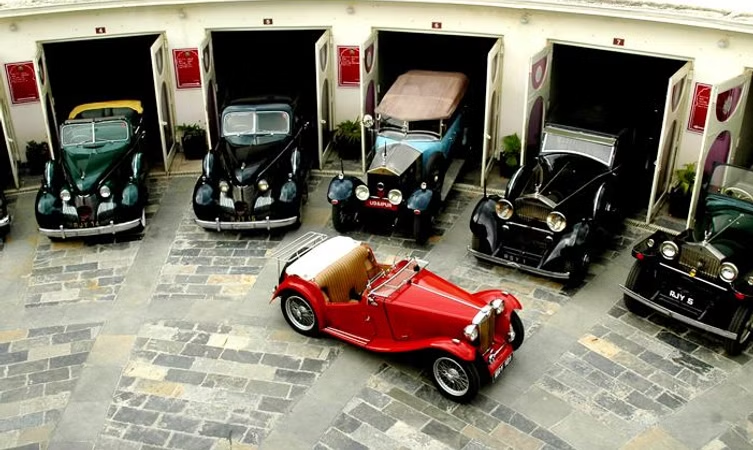
The Vintage Car Museum in Udaipur, also known as the Vintage and Classic Car Collection, is a fascinating destination for automobile enthusiasts and history buffs alike. Located just a short distance from the City Palace, the museum is housed within the premises of the Garden Hotel, an erstwhile royal garage. This exquisite collection showcases a range of vintage and classic cars, each meticulously preserved and maintained, offering a glimpse into the luxurious lifestyle of the Maharajas of Mewar. Among the highlights are the 1934 Rolls-Royce Phantom used in the James Bond film “Octopussy,” a 1938 Cadillac, and several rare Mercedes, Buicks, and MGs. Each vehicle in the collection has its own unique story and historical significance, reflecting the opulence and grandeur of Udaipur’s royal past. The Vintage Car Museum not only celebrates the legacy of classic automobiles but also serves as a testament to the rich heritage and refined taste of Udaipur’s royalty.
Jagdish Temple
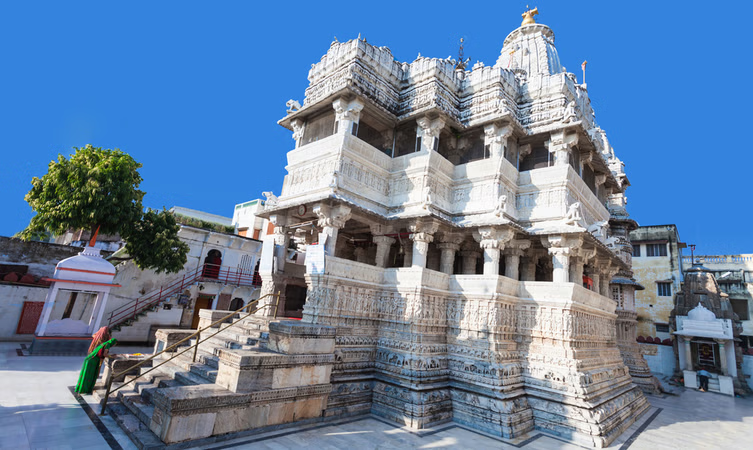
Jagdish Temple, an architectural marvel located in the heart of Udaipur, is a significant spiritual and cultural landmark. Dedicated to Lord Vishnu, the preserver of the universe in Hindu mythology, this grand temple was built in 1651 by Maharana Jagat Singh I. The temple’s stunning architecture features a magnificent Indo-Aryan style, with intricately carved pillars, elaborately adorned ceilings, and a towering spire that dominates the city’s skyline. The sanctum sanctorum houses a striking black stone idol of Lord Vishnu, known as Jagannath, and is surrounded by smaller shrines dedicated to various Hindu deities. The temple’s entrance is marked by a majestic stone staircase flanked by two massive stone elephants. The walls and pillars are adorned with exquisite sculptures depicting scenes from Hindu scriptures and mythological tales. Jagdish Temple is not only a place of worship but also a vibrant center of cultural heritage, attracting devotees and tourists alike who come to admire its artistic beauty and seek spiritual solace.
Bagore Ki Haveli
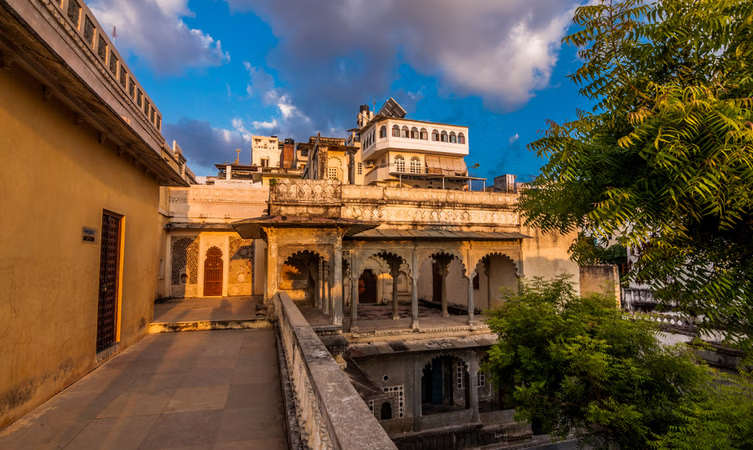
Bagore Ki Haveli, situated on the banks of Lake Pichola in Udaipur, is a splendid 18th-century mansion that epitomizes the grandeur and opulence of Rajasthan’s royal heritage. Built by Amar Chand Badwa, the Prime Minister of Mewar, the haveli boasts over a hundred rooms adorned with intricate mirror work, frescoes, and traditional Mewar architecture. Each room is a testament to the lavish lifestyle of the bygone era, showcasing a rich collection of royal artifacts, including costumes, jewelry, paintings, and turbans.
The haveli also features courtyards, balconies, jharokhas (overhanging enclosed balconies), and a beautiful terrace that offers panoramic views of the lake and the city. One of the highlights of Bagore Ki Haveli is the evening cultural show, “Dharohar,” which brings alive Rajasthani folk dances, music, and puppetry, providing visitors with a vibrant glimpse into the local culture and traditions. Bagore Ki Haveli is not just a museum; it is a lively cultural hub that celebrates the artistic and historical legacy of Udaipur.
Saheliyon Ki Bari

Saheliyon Ki Bari, or the “Garden of the Maidens,” is a charming and picturesque garden located on the banks of Fateh Sagar Lake in Udaipur. Built in the early 18th century by Maharana Sangram Singh for the royal ladies, this exquisite garden was designed as a serene retreat for the queen and her maids of honor. The garden is renowned for its lush green lawns, marble pavilions, intricately carved fountains, and delightful lotus pools.
One of the most captivating features of Saheliyon Ki Bari is its series of beautiful fountains, fed by the waters of Fateh Sagar Lake, which create a soothing and tranquil ambiance. The garden’s pathways are lined with tall trees and vibrant flower beds, making it a perfect place for leisurely strolls. Marble elephants, kiosks, and a delightful rain fountain, which simulates the effect of rain through its clever design, add to the garden’s allure. Saheliyon Ki Bari stands as a testament to the opulent lifestyle of Udaipur’s royalty and offers a peaceful oasis for visitors to escape the hustle and bustle of city life.
Gulab Bagh and Zoo
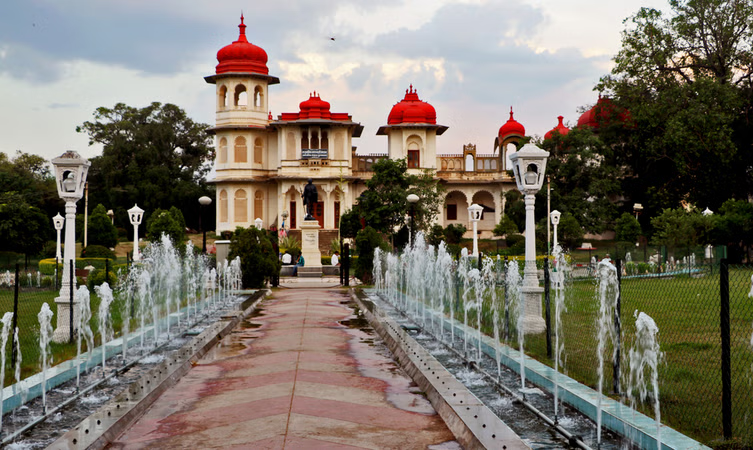
Gulab Bagh, also known as the “Rose Garden,” is a beautifully landscaped garden situated in Udaipur, Rajasthan. Established by Maharana Sajjan Singh in the late 19th century, this lush garden is renowned for its wide variety of roses and other ornamental plants. Spanning over 100 acres, Gulab Bagh features well-manicured lawns, colorful flower beds, and serene pathways, making it a popular spot for leisurely walks and relaxation.
Adjacent to Gulab Bagh is the Udaipur Zoo, also known as the Sajjangarh Zoo. Established within the garden’s grounds, the zoo houses a variety of wildlife species, including lions, tigers, leopards, and various birds. The zoo is designed to provide a naturalistic habitat for its residents and offers educational and recreational opportunities for visitors of all ages. The combination of Gulab Bagh’s floral beauty and the zoo’s diverse animal exhibits creates a unique destination that highlights both botanical and zoological wonders.
Sajjangarh Monsoon Palace
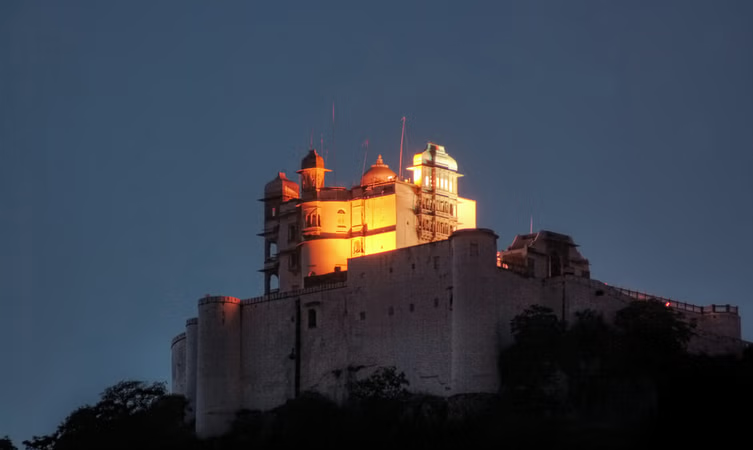
The Sajjangarh Monsoon Palace, perched atop a hill overlooking the city of Udaipur, is a majestic 19th-century palace known for its panoramic views and architectural elegance. Built by Maharana Sajjan Singh in 1884, the palace was originally intended as a retreat for the royal family to enjoy the monsoon rains and to observe the surrounding landscapes. The palace’s strategic location offers stunning vistas of the surrounding Aravalli Hills, Lake Pichola, and the city below.
The Sajjangarh Monsoon Palace is characterized by its distinctive white marble façade, expansive terraces, and intricately designed arches. Its elevated position and open spaces make it an ideal spot for watching the sunset and enjoying the beauty of the monsoon season. The palace is also surrounded by lush greenery and offers a serene escape from the city’s hustle and bustle. Today, the Sajjangarh Monsoon Palace stands as a testament to Udaipur’s royal heritage and provides visitors with a glimpse into the regal past while offering breathtaking natural views.
Jaisamand Lake
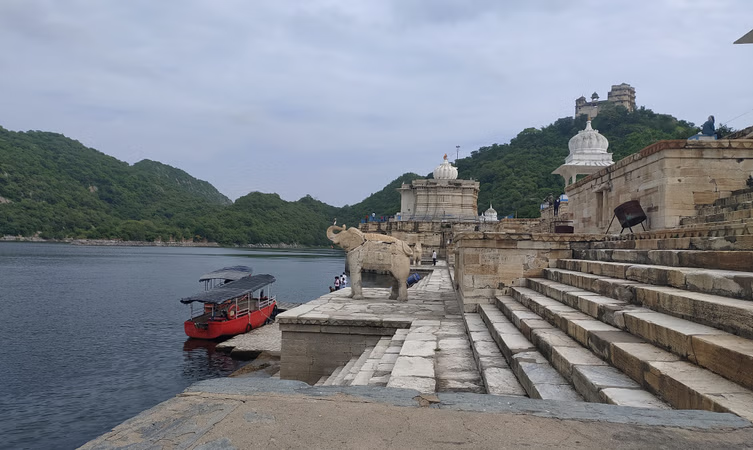
Jaisamand Lake, also known as Dhebar Lake, is one of the largest artificial lakes in India, located about 50 kilometers southeast of Udaipur in Rajasthan. Created in the 17th century by Maharana Jai Singh, the lake is a significant engineering feat, designed to provide water to the surrounding regions and support irrigation.
The lake spans approximately 87 square kilometers and is bordered by picturesque hills and lush vegetation, offering a serene and tranquil setting. Its vast expanse of water is dotted with several islands, and the area around the lake is a popular spot for boating and picnicking. The lake is also home to several marble cenotaphs and pavilions, adding to its historical and aesthetic appeal.
Jaisamand Lake is an important ecological site, supporting diverse flora and fauna. The surrounding area includes the Jaisamand Wildlife Sanctuary, which is home to various species of birds, animals, and plant life. The lake’s scenic beauty and tranquil environment make it a favored destination for nature lovers and those seeking a peaceful retreat amidst nature.
Jagmandir
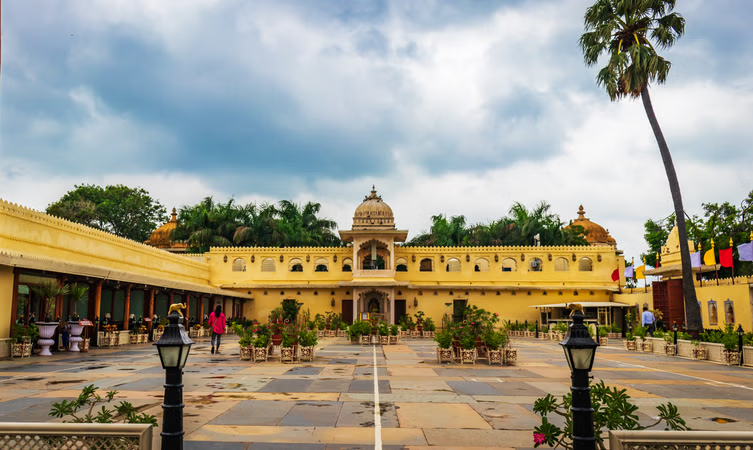
Jagmandir, also known as Jag Mandir, is an elegant island palace situated on Lake Pichola in Udaipur. Constructed during the 17th century by Maharana Jagat Singh I, the palace was originally intended as a summer retreat and a place for royal festivities. It is renowned for its stunning architecture and picturesque setting.
The palace features a blend of Mughal and Rajput architectural styles, with its white marble façade, intricately carved balconies, and serene courtyards. Jagmandir is distinguished by its beautiful lotus-shaped dome and the delightful gardens that surround it. Visitors can access the palace by boat, which adds to the experience of arriving at this tranquil and secluded retreat.
Jagmandir is also notable for its historic significance and romantic ambiance. It was a favored venue for grand celebrations, including a significant event where Shah Jahan, the future Mughal Emperor, was hosted by the Mewar rulers. The island palace remains a popular destination for tourists and offers breathtaking views of the lake and the surrounding cityscape, making it a cherished highlight of Udaipur’s rich cultural heritage.
Maharana Pratap Memorial
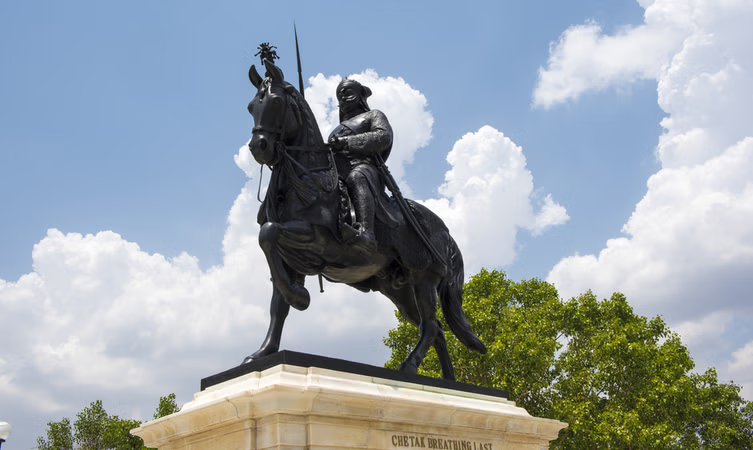
The Maharana Pratap Memorial, located on the Moti Magri (Pearl Hill) in Udaipur, is a tribute to the revered Rajput king Maharana Pratap Singh, known for his valor and resistance against the Mughal Empire. The memorial is situated on a hilltop offering panoramic views of the city and surrounding landscape, including the picturesque Fateh Sagar Lake.
The centerpiece of the memorial is an imposing bronze statue of Maharana Pratap, mounted on his loyal horse, Chetak. The statue captures the king in a heroic pose, symbolizing his bravery and unwavering spirit. The memorial also includes an adjoining museum that displays various artifacts, weapons, and historical information related to Maharana Pratap’s life and legacy.
The site is not only a historical monument but also a popular destination for visitors interested in Rajasthan’s rich heritage and the legendary tales of its warriors. The Maharana Pratap Memorial stands as a testament to the enduring legacy of one of Rajasthan’s most iconic figures, celebrating his contributions to the region’s history and culture.
Udaipur Solar Observatory
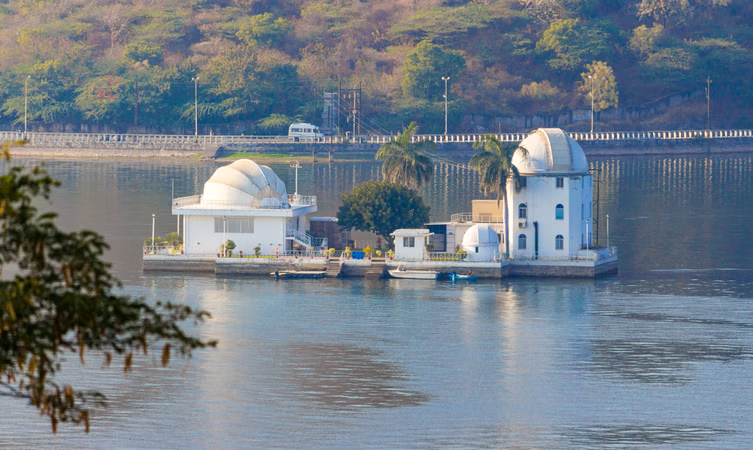
The Udaipur Solar Observatory, located on an island in Fateh Sagar Lake in Udaipur, Rajasthan, is one of the world’s largest solar observing sites. Established in 1976, it is renowned for its advanced research capabilities and significant contributions to solar physics.
The observatory is equipped with a range of sophisticated instruments, including high-resolution telescopes and spectrometers, to study various solar phenomena. It specializes in analyzing solar activity, such as sunspots, solar flares, and the solar corona, and contributes valuable data to our understanding of solar dynamics and space weather.
The Udaipur Solar Observatory’s unique location on an island provides an ideal environment for solar observation, free from the interference of city lights and atmospheric distortions. Its facilities and research have garnered international acclaim, making it a prominent center for solar research and an important contributor to the global scientific community.
Dudh Talai Musical Garden
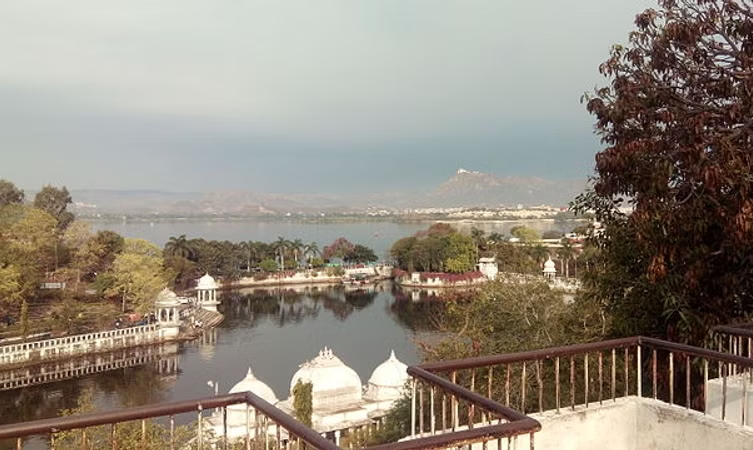
Dudh Talai Musical Garden, situated near Lake Pichola in Udaipur, is a charming and picturesque park known for its musical fountains and scenic views. The garden is nestled at the base of a hill and provides a serene retreat from the hustle and bustle of the city.
The main attraction of Dudh Talai Musical Garden is its musical fountain, which features a dynamic water show synchronized to music and colorful lights. The fountain creates an enchanting display, with water jets dancing in rhythm to the tunes, providing an enjoyable experience for visitors.
In addition to the musical fountain, the garden is adorned with well-maintained lawns, flower beds, and pathways that make it a pleasant spot for relaxation and leisure. The park offers panoramic views of the surrounding hills, Lake Pichola, and the city of Udaipur, enhancing its appeal as a tranquil escape. Dudh Talai Musical Garden is a popular destination for families and tourists seeking a blend of natural beauty and entertainment.
Eklingji Temple

Eklingji Temple, located about 22 kilometers north of Udaipur in the Eklingji village, is a significant and revered Hindu temple dedicated to Lord Shiva. This ancient temple complex, believed to have been built in the 8th century by the Mewar rulers, is a prominent pilgrimage site and an architectural marvel.
The temple is renowned for its stunning architecture, characterized by intricately carved marble and sandstone, as well as its elaborate sculptures and detailed frescoes. The central deity of the temple is a four-faced idol of Lord Shiva, known as Eklingji, which symbolizes his omnipresence. The temple complex also includes several smaller shrines dedicated to various deities, including Parvati, Ganesha, and Vishnu.
The Eklingji Temple is set amidst lush greenery and offers a serene and spiritual atmosphere. Its sacredness is enhanced by the daily rituals and ceremonies performed by the temple priests, making it a vital part of the religious and cultural life of Udaipur. The temple’s historical significance, combined with its architectural beauty and spiritual ambiance, makes it a must-visit destination for devotees and tourists alike.
Bada Mahal
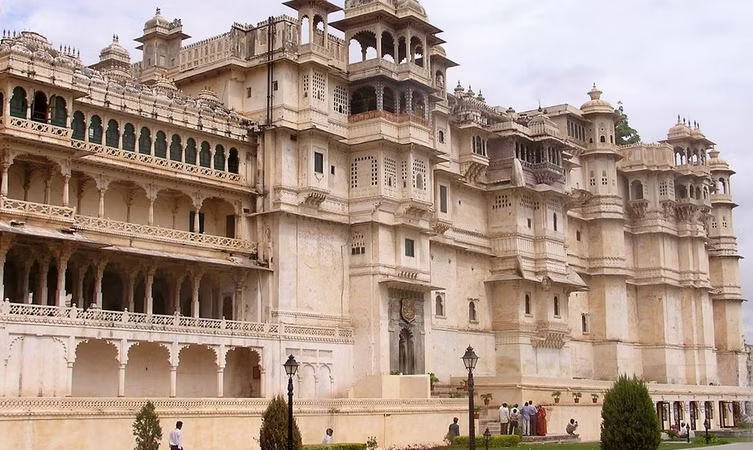
Bada Mahal, located within the City Palace complex in Udaipur, Rajasthan, is a striking example of Rajput architectural grandeur. This grand palace, which translates to “Big Palace,” is renowned for its imposing structure and elaborate design.
Constructed during the reign of Maharana Pratap, the Bada Mahal was originally used as a summer retreat and is situated on a high platform, offering panoramic views of the surrounding landscape, including Lake Pichola and the Aravalli Hills. The palace’s architecture reflects a harmonious blend of Rajput and Mughal styles, characterized by its elegant arches, intricately carved columns, and ornate courtyards.
The interiors of Bada Mahal are equally impressive, with beautifully decorated rooms featuring exquisite frescoes, intricate mirror work, and traditional Rajasthani motifs. The palace’s serene courtyards and gardens enhance its regal ambiance, making it a significant and picturesque part of Udaipur’s royal heritage. Bada Mahal stands as a testament to the opulence and artistic sensibilities of the Mewar dynasty, offering visitors a glimpse into the splendor of Rajasthan’s royal past.
Dine In Royalty at Sheesh Mahal
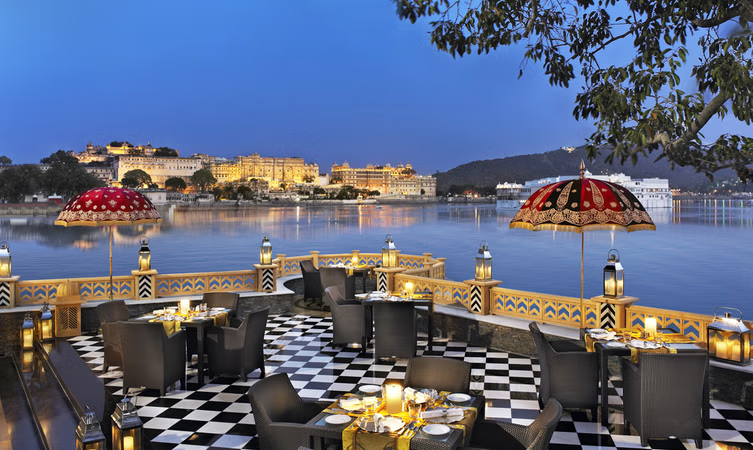
Dining at Sheesh Mahal, located within the City Palace in Udaipur, offers a truly royal experience. This stunning dining venue is renowned for its opulent setting and regal ambiance. The name “Sheesh Mahal” translates to “Palace of Mirrors,” and the restaurant lives up to its name with its exquisite mirror work, intricate carvings, and elaborate décor.
The dining area features beautifully restored interiors with elaborate chandeliers, ornate ceilings, and reflective glass panels that create a shimmering, enchanting atmosphere. The menu at Sheesh Mahal typically offers a selection of traditional Rajasthani cuisine, including rich curries, fragrant biryanis, and a variety of kebabs and desserts, all prepared with the highest quality ingredients and traditional methods.
Guests can enjoy their meals while overlooking the stunning views of Lake Pichola and the surrounding cityscape, adding to the dining experience’s grandeur. Dining at Sheesh Mahal is not just about the food; it’s about immersing oneself in the luxurious heritage and history of Udaipur’s
Gangaur Ghat
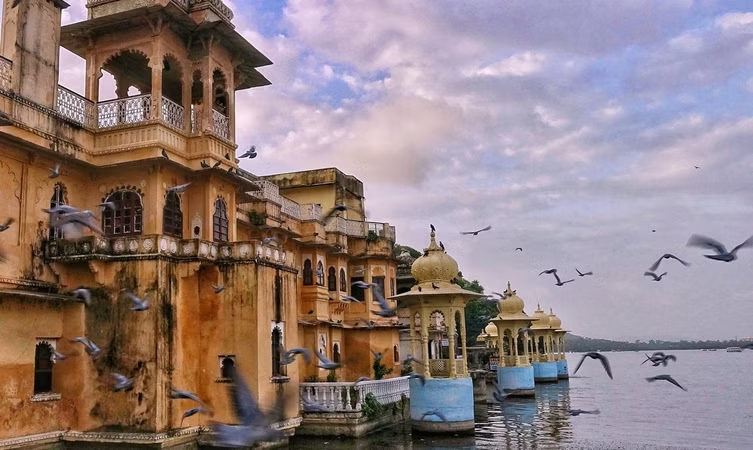
Gangaur Ghat, located on the western banks of Lake Pichola in Udaipur, is one of the city’s prominent and picturesque ghats. This historically and culturally significant ghat is primarily known for its association with the Gangaur Festival, a major annual celebration dedicated to the goddess Gauri, the consort of Lord Shiva.
The ghat is a vibrant and lively spot, especially during the festival, when it comes alive with processions, traditional music, dance performances, and colorful decorations. Devotees and locals gather at Gangaur Ghat to offer their prayers and participate in the festivities. The ghat also provides a scenic vantage point to enjoy the serene beauty of Lake Pichola and the stunning architectural backdrop of the City Palace.
The area around Gangaur Ghat features several traditional havelis and architectural marvels, adding to its charm. Visitors to Gangaur Ghat can experience a blend of cultural heritage and natural beauty, making it a memorable part of any visit to Udaipur.
Kumbhalgarh Fort
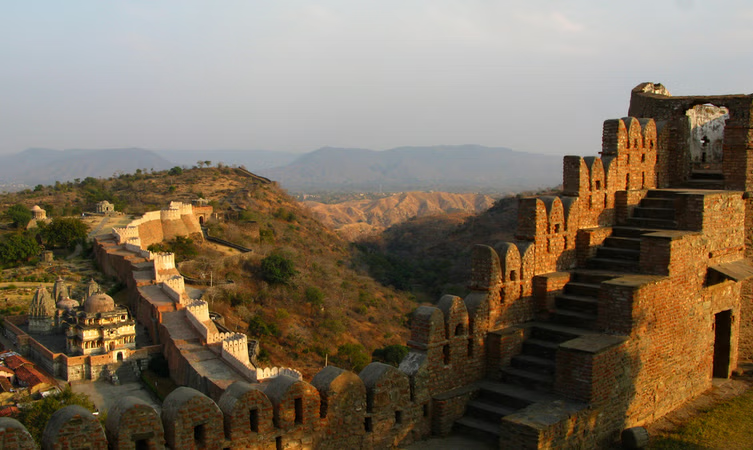
Kumbhalgarh Fort, located in the Rajsamand district of Rajasthan, is one of India’s most impressive and historically significant forts. Built in the 15th century by Maharana Kumbha, the fort is renowned for its massive walls, which stretch over 36 kilometers, making it one of the longest walls in the world.
Perched on the Aravalli Hills at an elevation of about 1,100 meters, Kumbhalgarh Fort offers breathtaking panoramic views of the surrounding landscape. The fort’s architecture is a splendid example of Rajput military ingenuity, featuring a series of defensive walls, bastions, and gates. Inside the fort, visitors can explore numerous temples, palaces, and reservoirs, each showcasing intricate carvings and impressive design.
The fort is also noted for its strategic location, which played a crucial role in the defense of the Mewar region. It is a UNESCO World Heritage Site, recognized for its historical and architectural significance. The fort’s remote location and rugged terrain add to its mystique, making it a fascinating destination for history enthusiasts and travelers seeking to experience Rajasthan’s rich heritage.
Chittorgarh Fort
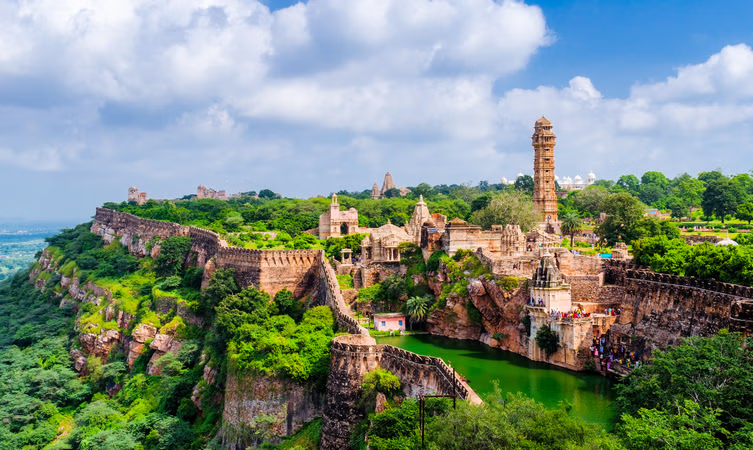
Chittorgarh Fort, located in Chittorgarh, Rajasthan, is one of India’s largest and most formidable forts, and a significant symbol of Rajput valor and history. Built in the 7th century by the Mauryan rulers, the fort has been a key site of numerous historical battles and sieges, reflecting the bravery and resilience of the Rajput rulers.
The fort complex spans over 700 acres and is enclosed by massive walls that stretch approximately 13 kilometers. Within its vast expanse, visitors can explore a range of architectural marvels, including palaces, temples, and reservoirs. Notable structures within the fort include the Vijay Stambh (Victory Tower), which commemorates Maharana Kumbha’s victory over the Sultan of Malwa, and the Kirti Stambh (Tower of Fame), dedicated to the Jain saint Adinatha.
Chittorgarh Fort is also renowned for its association with the legendary Queen Padmini and the valiant Rajput leader Maharana Pratap. The fort’s history is marked by stories of heroism, sacrifice, and the fierce battles fought to defend its walls. Today, Chittorgarh Fort stands as a UNESCO World Heritage Site, celebrating its rich heritage and architectural splendor, and serving as a poignant reminder of Rajasthan’s storied past.
famous market of udaipur
Hathi Pol Bazaar
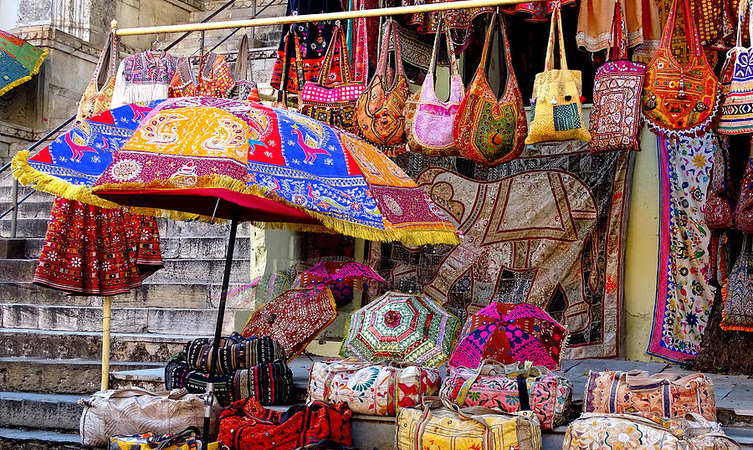
Hathi Pol Bazaar, located in Udaipur, is a vibrant and bustling market known for its traditional Rajasthani crafts and souvenirs. Situated near the City Palace, this market offers a rich array of local products and is a popular destination for both tourists and locals.
The bazaar is renowned for its diverse selection of goods, including handcrafted textiles, colorful garments, intricate jewelry, traditional Rajasthani art, and souvenirs. Visitors can explore a variety of stalls and shops selling everything from embroidered fabrics and block-printed textiles to hand-painted souvenirs and antique artifacts.
Hathi Pol Bazaar also provides an opportunity to experience the lively atmosphere of Udaipur’s markets, with its vibrant colors, lively interactions, and the chance to engage with local artisans. It is an excellent place to pick up unique gifts and immerse oneself in the rich cultural heritage of Rajasthan.
Bada Bazaar
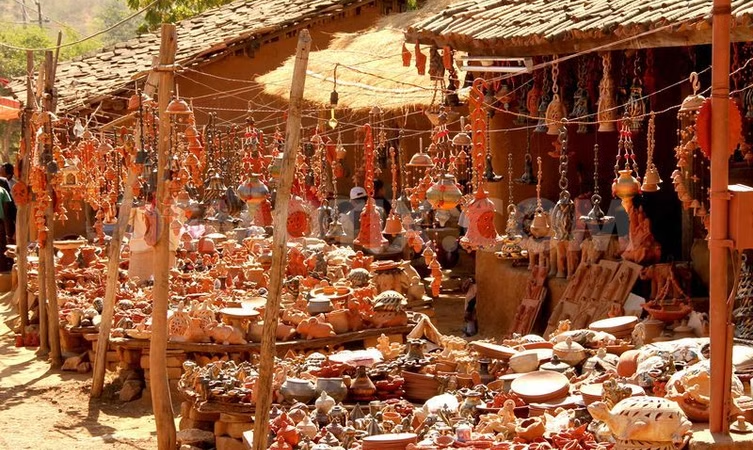
Bada Bazaar, also known as the “Big Market,” is a bustling and historic market located in the heart of Udaipur. Renowned for its vibrant atmosphere and wide range of products, Bada Bazaar is one of the city’s most prominent commercial hubs.
The market is famous for its diverse offerings, including traditional Rajasthani textiles, colorful clothing, jewelry, handicrafts, and a variety of spices and local goods. Shoppers can find an array of items such as embroidered fabrics, block-printed textiles, and intricate jewelry pieces. The bazaar is also known for its lively street food scene, with numerous stalls and eateries serving delicious local snacks and sweets.
Bada Bazaar is not just a shopping destination but also a cultural experience. The market’s bustling streets, historic architecture, and lively ambiance provide a glimpse into the vibrant everyday life of Udaipur. Visitors can explore the market’s narrow lanes, interact with local vendors, and enjoy the rich sensory experience of traditional Rajasthani commerce.
Rajasthali
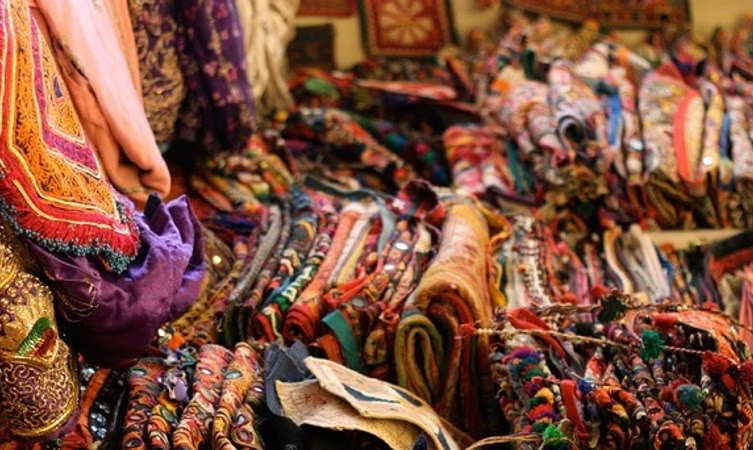
Rajasthali is a government-run emporium located in Udaipur, Rajasthan, and serves as a premier destination for traditional Rajasthani handicrafts and textiles. Operated by the Rajasthan State Handloom and Handicraft Development Corporation, Rajasthali offers a curated selection of authentic Rajasthani products, including exquisite textiles, jewelry, pottery, paintings, and handicrafts.
The emporium is known for its high-quality goods, ranging from intricately embroidered fabrics and block-printed textiles to hand-painted miniatures and traditional jewelry. It provides a platform for local artisans and craftsmen to showcase their work, ensuring that visitors have access to genuine and well-crafted Rajasthani items.
Rajasthali is a popular spot for tourists looking to purchase souvenirs and gifts, as well as for those interested in exploring the rich cultural heritage of Rajasthan. The store’s carefully curated collection and its commitment to preserving traditional craftsmanship make it a valuable destination for both locals and visitors.
Bapu Bazaar
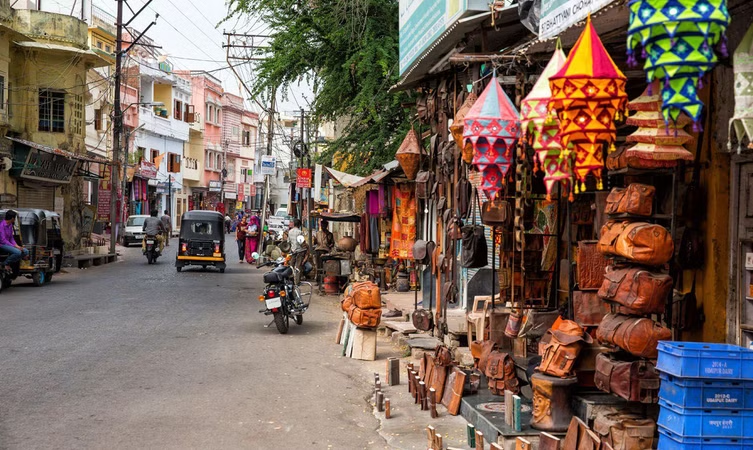
Bapu Bazaar, situated in the heart of Udaipur, is a vibrant and lively market renowned for its diverse range of products and traditional Rajasthani atmosphere. Named after Mahatma Gandhi, also known as Bapu, the bazaar is a popular shopping destination for both locals and tourists.
The market is famous for its wide array of goods, including colorful textiles, handcrafted jewelry, traditional Rajasthani clothing, and a variety of souvenirs. Shoppers can explore stalls selling embroidered fabrics, block-printed garments, and intricate handicrafts. The bazaar also features a range of local sweets, snacks, and spices, offering visitors a taste of Rajasthani cuisine.
Bapu Bazaar is known for its bustling and energetic ambiance, with lively interactions between vendors and customers, and a vibrant display of Rajasthani culture. It provides an immersive shopping experience, allowing visitors to engage with local artisans and take home unique, handcrafted items that reflect the rich heritage of Rajasthan.
famous food in udaipur
Poornima – Vada Pav
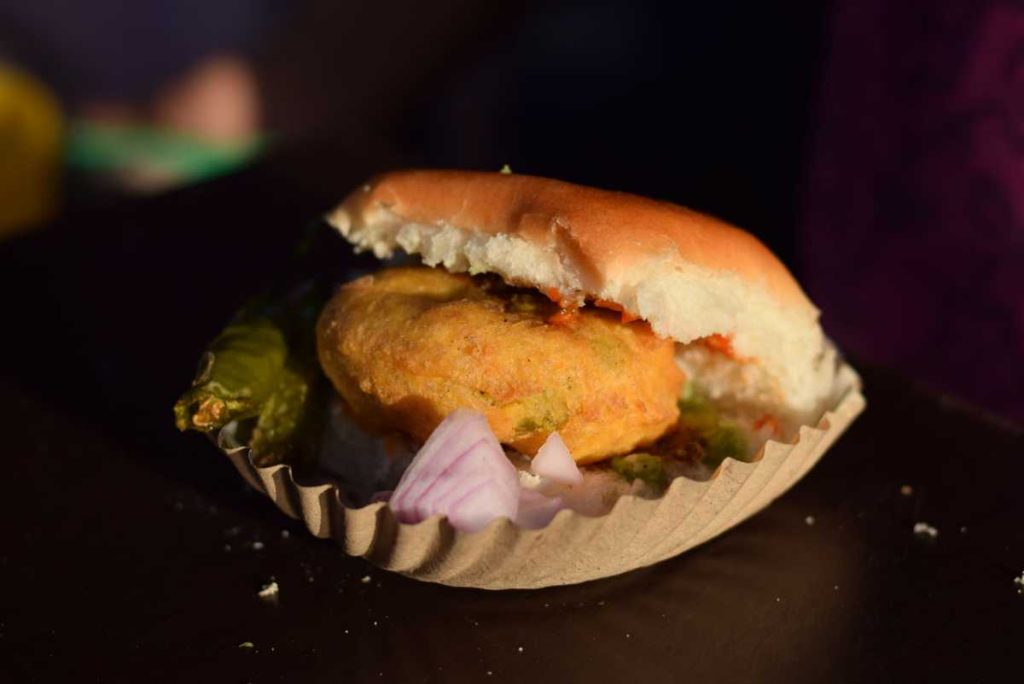
One of India’s absolute favourite street food is the Vada Pav. A crisply fried potato patty is placed horizontally inside a soft bun with a generous spread of spicy green chutney and a fried chilly on the side. This authentic Marathi snack is a crowd-pleaser. Replicating the taste of a staple Maharastran Vada Pav, the Poornima Vada Pav stall in Udaipur is sold out every day! Awaken your taste buds with this spicy and flavorful street food in Udaipur.
Jain Nashta Centre – Poha
famously known as the Kashmir of Rajasthan, offering a serene boating experience amidst the Aravalli Hills.
Did someone say yummy roadside poha? The Jain Nashta Centre is famous for its light, fat-free and fresh poha it serves every day along with staples like samosa, namkeen, tea and coffee. A favourite breakfast in the states of Rajasthan, Gujarat and Madhya Pradesh, poha with a cup of hot masala chai is ideal for quenching all your breakfast cravings at Chauraha Road in Udaipur.
Vinod Coffee House
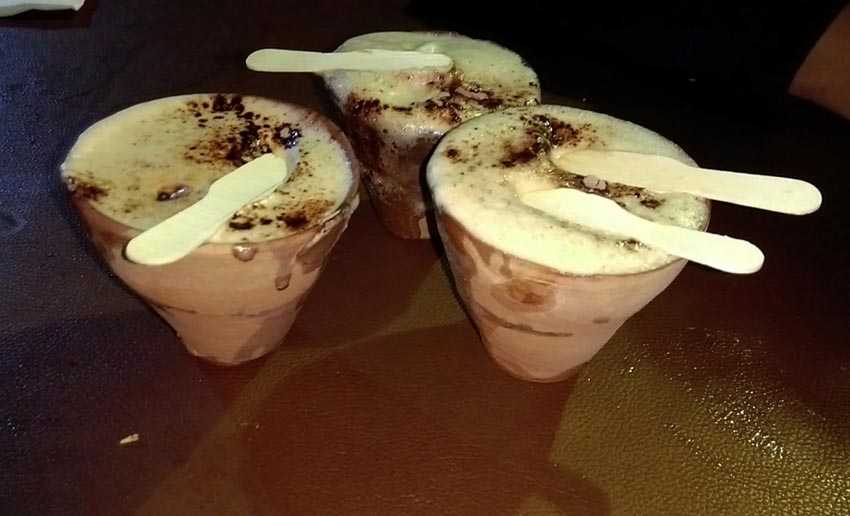
Udaipur’s famous hangout for the youth, Vinod Coffeehouse serves authentic Kulhad tea and coffee with small bites. Kulhad, earthen clay pots, add a beautiful rustic flavour to the drink. With the breathtaking Fateh Sagar Lake as its background, this tapri offers more than just hot beverages. Enjoy a warm cuppa as you take in the natural beauty with this amazing street food in Udaipur.
Chetak – Boiled Egg Bhurji
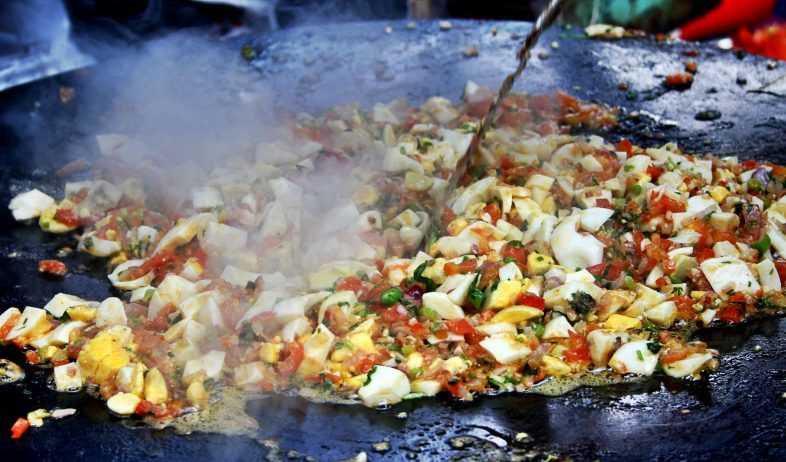
Egg bhurji with a twist, Chetak’s famous boiled, scrambled egg curry is as mysterious as it sounds. A secret recipe of Udaipur’s oldest family-run stall, here you will find the quintessential boiled egg cooked on a flat pan with hearty gravy. The gravy is made with onions, tomatoes, and spices that add a zing to the egg. Try this egg-licious dish with bread on a pleasant winter evening at Udaipur
Panchwati – Maggi, and Sandwich
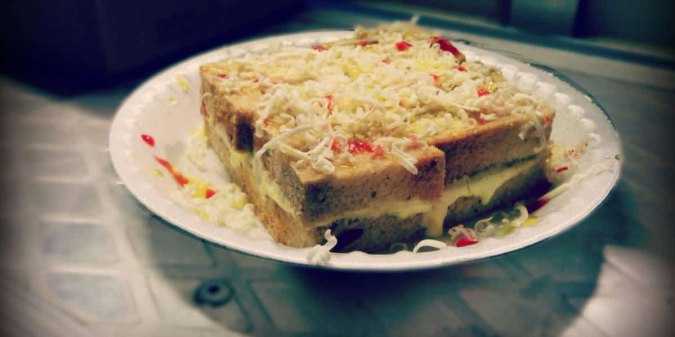
A plate full of warm happiness and yummy sandwiches are a mood-uplifting snack. Grab Udaipur’s best potato, chutney, and cheese sandwiches with a plate of hot masala Maggi for an indulgent evening of gluttony. Tourists from across the globe come here to indulge in some hearty street food in Udaipur.




